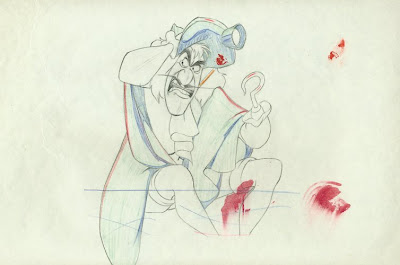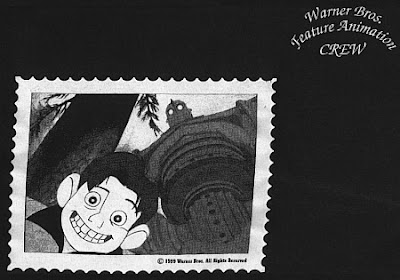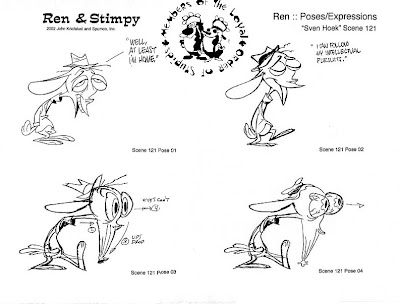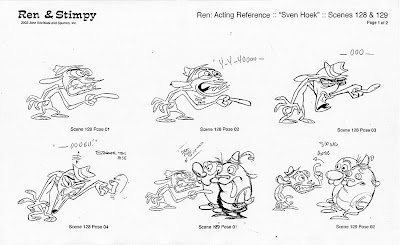
Cartoon Expressions:
Early cartoon expressions covered only the most general emotions in the simplest graphic way.
Happy
 This is only happy. Not any particular kind of happy for any particular situation.
This is only happy. Not any particular kind of happy for any particular situation.There isn't a shade to the happy.
It's not specific to a particular character either.
This happy smile can be pasted onto any character in any situation.
It works for most purposes in old cartoons, because old cartoons weren't about acting.
They have lots of other qualities.

Angry
 This angry expression can be applied to any character. It doesn't define any particular type of anger or any specific character. It's a general visual symbol that we can instantly recognize.
This angry expression can be applied to any character. It doesn't define any particular type of anger or any specific character. It's a general visual symbol that we can instantly recognize.


 Sad
Sad

 This Donald is probably confusion, bit it's not graphically different than just plain sad.
This Donald is probably confusion, bit it's not graphically different than just plain sad.Surprise


Screwy-Happy

Confused, Eager

Determined

 Most cartoon expressions can be described with a single adjective - Happy, Sad, Mad, Surprised etc...
Most cartoon expressions can be described with a single adjective - Happy, Sad, Mad, Surprised etc...These expressions represent the simplest and most basic emotions.
These are all instantly recognizable and relate able by the audience.
Then there are kinds of expression that were invented for animated cartoons. Particularly Disney style animated cartoons.
Animation Expressions
 These aren't really expressions. They are merely animation tricks to keep the character looking asymmetrical and pliable, and thus somewhat alive.
These aren't really expressions. They are merely animation tricks to keep the character looking asymmetrical and pliable, and thus somewhat alive.
These expressions are made with a simple formula.
Squash one side of the face while stretching the other.

Squash one side of the face while stretching the other.


This adds a seemingly slight dimension to the symmetrical type of general expressions. But it doesn't add any actual definition to the emotion.
It's an animation trick that many animators rely on to make their characters seem organic.
IT'S ALL THIS GUY'S FAULT!

 In this elaborate piece of highly skilled magical animation, there aren't any drawings of specific expressions. The animation is all about the subtle overlapping squash and stretch and difficult actions and timings.
In this elaborate piece of highly skilled magical animation, there aren't any drawings of specific expressions. The animation is all about the subtle overlapping squash and stretch and difficult actions and timings."Organic" equals "Alive" to many animators.



This is a beautiful, well constructed and composed drawing, but it has only the simplest possible expression.


 These aren't even expressions. They are less expressive than the basic Happy, sad, mad, surprised expressions. At least humans can understand those simple emotions. These kinds of expressions are for animators, not general humanity.
These aren't even expressions. They are less expressive than the basic Happy, sad, mad, surprised expressions. At least humans can understand those simple emotions. These kinds of expressions are for animators, not general humanity.
These types of squashed and stretched animation exercises don't represent any kind of human emotion that you can identify with. They avoid the problem of acting by replacing it with animation tricks - smooth actions that seemingly keep the characters alive merely because they feel organic.
Now I love classic cartoons, but usually for other reasons than acting. Animators love to quote: "An animator is an actor with a pencil." But if you acted out an animated scene from your favorite Disney movie in real life to a live actor, he would fall to the floor laughing at how unnatural it is.
Now I love classic cartoons, but usually for other reasons than acting. Animators love to quote: "An animator is an actor with a pencil." But if you acted out an animated scene from your favorite Disney movie in real life to a live actor, he would fall to the floor laughing at how unnatural it is.
Modern animation expressions
Modern animation has taken the unnatural unrelatable expression idea from classic cartoons to a hideous extreme.
 Here's no expression at all.
Here's no expression at all.
This is the actor with a pencil's automatic response to a male character falling in love. It's in every animated feature since it first appeared in Jungle Book. These kinds of expressions are done by animators who have never observed real people in the real world. They don't get their ideas of personality and acting from anyone they've ever met, or from real actors in movies and TV. They get them from animated feature films and Cal Arts student films and for generations keep redrawing them by rote. I'm sure every artist is capable of more, they just haven't thought of it yet.
These kinds of expressions are done by animators who have never observed real people in the real world. They don't get their ideas of personality and acting from anyone they've ever met, or from real actors in movies and TV. They get them from animated feature films and Cal Arts student films and for generations keep redrawing them by rote. I'm sure every artist is capable of more, they just haven't thought of it yet.
 These kinds of expressions are done by animators who have never observed real people in the real world. They don't get their ideas of personality and acting from anyone they've ever met, or from real actors in movies and TV. They get them from animated feature films and Cal Arts student films and for generations keep redrawing them by rote. I'm sure every artist is capable of more, they just haven't thought of it yet.
These kinds of expressions are done by animators who have never observed real people in the real world. They don't get their ideas of personality and acting from anyone they've ever met, or from real actors in movies and TV. They get them from animated feature films and Cal Arts student films and for generations keep redrawing them by rote. I'm sure every artist is capable of more, they just haven't thought of it yet.
Now animators have mixed Anime in with 70s Disney/Bluth style and Saturday Morning Cartoon construction. If you ever met anyone who made faces like these, would you hang out with him?
If you ever met anyone who made faces like these, would you hang out with him?
 If you ever met anyone who made faces like these, would you hang out with him?
If you ever met anyone who made faces like these, would you hang out with him?



This is the Cal Arts style that originates from Valencia, California. It's a look derived from 60s Disney cartoons, a few stock animation expressions, liberally mixed with a gay flourish.
 This "wacky" expression seems to be in every feature now.
This "wacky" expression seems to be in every feature now. And in case you think this style is a thing of the past-as someone said in the comments, here it still is:
And in case you think this style is a thing of the past-as someone said in the comments, here it still is:


Warner Bros. More Specific Expressions and Designs
 As I've pointed out before, Warner Bros. went quite a bit further in doing more specific acting. They started by drawing more specific expressions. More relatable characters. They took the first steps in making their characters act like real people, rather than always relying on stock Walt approved expressions.
As I've pointed out before, Warner Bros. went quite a bit further in doing more specific acting. They started by drawing more specific expressions. More relatable characters. They took the first steps in making their characters act like real people, rather than always relying on stock Walt approved expressions. http://www2.blogger.com/post-edit.g?blogID=22406604&postID=115906579687901195
http://www2.blogger.com/post-edit.g?blogID=22406604&postID=115906579687901195 Live Action Expressions
Live Action ExpressionsThe best acted animation in history is still not anywhere near what live actors can do in real time automatically.


 In one scene from the Honeymooners, you can pick out more specific expressions than in the whole history of feature animation. (Marc is gonna give me lots more frame grabs of really specific expressions and poses from the Honeymooners for further posts.)
In one scene from the Honeymooners, you can pick out more specific expressions than in the whole history of feature animation. (Marc is gonna give me lots more frame grabs of really specific expressions and poses from the Honeymooners for further posts.)Expressions that can't be described even with 20 adjectives but are instantly felt, understood and enjoyed by the audience.
Specific to the characters: Alice makes different kinds of expressions than Ralph
Specific to the scene situation and emotion
Specific to each frame of film in many instances.
Animation can just not compete on an acting level with live action. It takes forever to draw 10 seconds of film. It takes 10 seconds to act it in real life.
Does it need to? Not always. Tex Avery cartoons have just enough funny specific expressions to get the cartoon gags across and lots or unreal impossible expressions that live actors could never do.
Can animation benefit from better acting? Sure. But if you want to be a better actor in animation, don't study animation for acting. Study your friends and family. Study classic movies and sitcoms. Study evangelists on the Jesus channel. Look for uniqueness and entertainment and individuality.
Start by observation of the real. Look for funny quirky expressions that people you know make that are unique to them. Understand real people's personalities and draw them-don't translate them into stock Cal Arts expressions!
But don't merely do realistic acting...because you'll never be as good as live action. You have to be better so add exaggeration and impossible stuff that only cartoons can do.
Ren and Stimpy stood out from all other cartoons in 1991, not because of beautiful fluid animation, or solid principles or great timing. 30s and 40s cartoons beat the crap out of us. The thing that really made it different is that I tried to make the characters seem real. People aren't used to seeing cartoon characters act like people they know so it seemed shocking when it hit. I don't study cartoons for my acting. I study people and figure out ways to draw individual expressions, poses and emotions that not many have ever attempted in animation. I will show you as best I can how I did that.
Anyway, this is just part 1 of a series on cartoon acting. There is a lot more to cover and I just wanted to put down some basic visual vocabulary of terms for you.
 A combination of "realistic" human expressions with expressions that can only happen in cartoons....
A combination of "realistic" human expressions with expressions that can only happen in cartoons....


